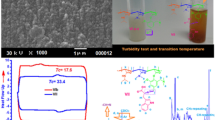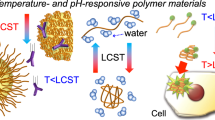Abstract
By the reaction of poly(acryloyl chloride) with N-(3-aminopropyl)imidazole, poly(N-(3-(1H-imidazol-1-yl)propyl)acrylamide) was synthesized. The new polymer contains an imidazole ring removed from the main chain by a spacer of five bonds. The structure and purity, molecular weight, hydrodynamic and thermosensitive properties of the obtained sample were studied by 1H- and 13C-NMR, FTIR spectroscopy, acid-base titration, light scattering, turbidimetry and viscometry. The observed ability of the imidazole-containing polymer to form and destroy associates in water-salt solutions at pH 6.6–7.4 and temperatures of 29–48 °C indicates that these are promising candidates for designing complex biomedical systems. The new polymer is able to form complexes with oligo-DNA more actively than poly(1-vinylimidazole), which is of interest for gene delivery applications. The polymer cross-linked with epichlorohydrin gives micro-relief coatings on the plastic surface, and the modified surface is able to attach negatively charged objects. This thermo- and pH-sensitive polymer modification can be applied to create finely controlled surfaces for cell culturing.
Similar content being viewed by others
References
Wei, M.; Gao, Y.; Li, X.; Serpe, M. J. Stimuli-responsive polymers and their applications. Polym. Chem., 2017, 8, 127–143.
Cabane, E.; Zhang, X.; Langowska, K.; Palivan, C. G.; Meier, W. Stimuli-responsive polymers and their applications in nanomedicine. Biointerphases, 2012, 7, 9.
Bawa, P.; Pillay, V.; E Choonara, Y.; Toit, L. C. Stimuli-responsive polymers and their applications in drug delivery. Biomed. Mater., 2009, 4, 022001.
Gandhi, A.; Paul, A.; Sen, S. O.; Sen, K. K. Studies on thermoresponsive polymers: Phase behaviour, drug delivery and biomedical applications. Asian J. Pharm. Sci., 2015, 10, 99–107.
Kocak, G.; Tuncer, C.; Bütün, V. pH-Responsive polymers. Polym. Chem., 2017, 8, 144–176.
Ward, M. A.; Georgiou, T. K. Thermoresponsive polymers for biomedical applications. Polymers, 2011, 3, 1215–1242.
Simonova, M. A.; Zakharova, N. V.; Khayrullin, A. R.; Filippov, A. P.; Annenkov, V. V. Behavior of double stimuli-responsive copolymer of N(3-(diethylamino)propyl)-N-methylacrylamide and N-N-diethylacrylamide in aqueous solutions. Int. J. Polym. Anal. Charact., 2018, 23, 236–243.
Zakharova, N. V.; Simonova, M. A.; Filippov, A. P.; Zelinskiy, S. N.; Annenkov, V. V. Synthesis, molecular characteristics, and stimulus-sensitivity of graft-copolymer of chitosan poly(N,N-diethylacrylamide). J. Molecular Liq., 2019, 292, 111355.
Pilipenko, I. M.; Korzhikov-Vlakh, V. A.; Zakharova, N. V.; Tennikova, T. B.; Urtti, A. Thermo- and pH-sensitive glycosaminoglycans derivatives obtained by controlled grafting of poly(N-isopropylacrylamide). Carbohydr. Polym., 2020, 248, 116764.
Kyriakides, T.; Cheung, C.; Murthy, N., Bornstein, P.; Stayton, P.; Hoffman, A. J. pH-Sensitive polymers that enhance intracellular drug delivery in vivo. Control. Rel., 2002, 78, 295–303.
Drummond, D.; Zignani, M.; Leroux, J. Current status of pH-sensitive liposomes in drug delivery. Prog. Lipid Res., 2000, 39, 409–460.
Durfresne, M.; Garrec, D.; Sant, V.; Leroux, J.; Ranger, M. Preparation and characterization of water-soluble pH-sensitive nanocarriers for drug delivery. Int. J. Pharmaceutics, 2004, 277, 81–90.
Gerasimov, O.; Boomer J.; Qualls M.; Thompson D. Cytosolic drug delivery using pH- and light-sensitive liposomes. Adv. Drug Deliv. Rev., 1999, 38, 317–338.
Liu, D.; Sun, J. Thermoresponsive Polypeptoids. Polymers, 2020, 12, 2973.
Zhang, Y.; Broekhuis, A. A.; Stuart, M. C. A.; Picchioni, F. Polymeric amines by chemical modifications of alternating aliphatic polyketones. J. Appl. Polym. Sci., 2008, 107, 262–271.
Bütün, V.; Weaver, J. V. M.; Bories-Azeau, X.; Cai, Y.; Armes, S. P. A brief review of ‘schizophrenic’ block copolymers. React. Funct. Polym., 2006, 66, 157–165.
Smedt, S. C. D.; Demeester, J.; Hennink, W. E. Cationic polymer based gene delivery systems. Pharm. Res., 2000, 17, 113–126.
Allen, M. H. Jr.; Day, K. N.; Hemp, S. T.; Long, T. E. Synthesis of folic acid-containing imidazolium copolymers for potential gene delivery applications. Macromol. Chem. Phys., 2013, 214, 797–805.
Danilovtseva, E. N.; Krishnan, U. M.; Pal’shin, V. A.; Annenkov, V. V. Polymeric amines and ampholytes derived from poly(acryloyl chloride): synthesis, influence on silicic acid condensation and interaction with nucleic acid. Polymers, 2017, 9, 624.
Ofridam, F.; Tarhini, M.; Lebaz, N.; Gagnière, É.; Mangin, D.; Elaissari, A. pH-sensitive polymers: classification and some fine potential applications. Polym. Adv. Technol. 2021, 32, 1455–1484.
Oda, Y.; Kanaoka, S.; Aoshima, S. Synthesis of dual pH/temperature-responsive polymers with amino groups by living cationic polymerization. J. Polym. Sci, Part A: Polym. Chem., 2010, 4, 1207–1213.
Gil, E. S.; Hudson, S. M. Stimuli- responsive polymers and their bioconjugate. Prog. Polym. Sci., 2004, 29, 1173–1222.
SPARC. pKa/property server. Ver 4.2 Mar. 2008. Available from, as of October 28, 2009: https://ibmlc2.chem.uga.edu/sparc/.
Albert, A. Heterocyclic chemistry. 2nd Ed.; Athlone Press, 1968.
Sundberg, R. J.; Martin, R. B. Interactions of histidine and other imidazole derivatives with transition metal ions in chemical and biological systems. Chem. Rev., 1974, 74, 471–517.
Nozaki, Y.; Gurd, F. R. N.; Chen, R. F.; Edsall, J. T. The association of 4-methylimidazole with the ions of cupric copper and zinc; with some observations on 2,4-dimethylimidazole. J. Am. Chem. Soc., 1957, 79, 2123–2129.
Pozdnyakov, A. S.; Emel’yanov, A. I.; Korzhova, S. A.; Kuznetsova, N. P.; Bolgova, Y. I.; Trofimova, O. M.; Semenova, T. A.; Prozorova, G. F. Green synthesis of stable nanocomposites containing copper nanoparticles incorporated in poly-N-vinylimidazole. Polymers, 2021, 13, 3212.
Luo, X. F.; Goh, S. H.; Lee, S. Y. Miscibility and interpolymer complexation of poly(1-vinylimidazole) with hydroxyl- and carboxyl-containing polymers. Makromol. Chem. Phys., 1999, 200, 399–404.
Isikli, S.; Tuncagil, S.; Bozkurt, A.; Toppare, L. Immobilization of invertase in a novel proton conducting poly(vinylphosphonic acid—poly(1-vinylimidazole) network. J. Macromol. Sci. Part A, 2010, 47, 639–646.
Asayama, S.; Nishinohara, S.; Kawakami, H. Zinc-chelated poly(1-vinylimidazole) and a carbohydrate ligand polycation form DNA ternary complexes for gene delivery. Bioconjugate Chem., 2011, 22, 1864–1868.
Danilovtseva, E. N.; Zelinskiy, S. N.; Pal’shin, V. A.; Kandasamy, G.; Krishnan, U. M.; Annenkov, V. V. Poly(1-vinylimidazole) prospects in gene delivery. Chinese J. Polym. Sci., 2019, 37, 637–645.
Mazyar, N. L.; Annenkov, V. V.; Kruglova, V. A.; Ananiev, S. M.; Danilovtseva, E. N.; Rokhin, A. V.; Zinchenko, S. V. Acid-base properties of poly(1-vinylazoles) in aqueous solution. Rus. Chem. Bull. Intern. Ed., 2000, 49, 2013–2017.
Sharma, A.; Srivastava, A. Pronounced influence of pH, metal-ion and solvent isotope on the thermoresponse of synthetic amphiphilic polypeptides. Polym. Chem., 2013, 4, 5119–5128.
Seo, K.; Kim, D. Phase transition behavior of novel pH-sensitive polyaspartamide derivatives grafted with 1-(3-aminopropyl)imidazole. Macromol. Biosci., 2006, 6, 758–766.
Bogomolova, A.; Kaberov, L.; Sedlacek, O.; Filippov, S. K.; Stepanek, P.; Král, V.; Wang, X. Y.; Liu, S. L.; Ye, X. D.; Hruby, M. Double stimuli-responsive polymer systems: how to use crosstalk between pH- and thermosensitivity for drug depots. Eur. Polym. J., 2016, 84, 54–64.
Naka, K.; Masuoka, S.; Shinke, R.; Yamada, M. Synthesis of first-and second-generation imidazoleterminated POSS-core dendrimers and their pH responsive and coordination properties. Polym. J., 2012, 44, 353–359.
Handel, T. M.; Ponticello, I. S.; Tan, J. S. Effects of side-chain structure on polymer conformation: synthesis and dilute solution properties. Macromolecules, 1987, 20, 264–267.
Zakharova, N. V.; Filippov, A. P.; Zelinskii, S. N.; Danilovtseva, E. N.; Annenkov, V. V. The influence of composition of thermo- and pH-sensitive copolymers of N-(3-(hiethylnmipo)propyl)-N-methylacrylamide and N, N-diethylacrylamide on their behavior in aqueous solutions. Polym. Sci. A, 2019, 61, 1–8.
Annenkov, V. V.; Danilovtseva, E. N.; Zelinskiy, S. N.; Basharina, T. N.; Safonova, T. A.; Korneva, E. S.; Likhoshway, Ye. V.; Grachev, M. A. Novel fluorescent dyes based on oligopropylamines for the in vivo staining of eukaryotic unicellular algae. Anal. Biochem., 2010, 407, 44–51.
Annenkov, V. V.; Danilovtseva, E. N.; Likhoshway, Y. V.; Patwardhan, S. V.; Perry C. C. Controlled stabilisation of silicic acid below pH 9 using poly(1-vinylimidazole). J. Mater. Chem., 2008, 18, 553–559.
Buruiana, E.C.; Buruiana, T.; Hahui, L. Preparation and characterization of new optically active poly(N-acryloyl chloride) functionalized with (S)-phenylalanine and pendant pyrene. J. Photochem. Photobiol. A, 2007, 189, 65–72.
Sandeli, E. B.; West, T. S. Recommended nomenclature for titrimetric analysis. Pure Appl. Chem., 1969, 18, 427–436.
Danilovtseva, E. N.; Verkhozina, O. N.; Zelinskiy, S. N.; Ivanov, N. A.; Tsiganov, P.Y.; Basharina, T. N.; Annenkov, V. V. New fluorescent derivatives of oligopropylamines. ARKIVOC, 2013, 3, 266–281.
González-de-Castro, Á.; Broughton, H.; Martínez-Pérez, J. A.; Espinosa, J. F. Conformational features of secondary N-cyclopropyl amides. J. Org. Chem., 2015, 80, 3914–3920.
Lanyon-Hogg, T.; Ritzefeld, M.; Masumoto, N.; Magee, A. I.; Rzepa, H. S.; Tate, E. W. Modulation of amide bond rotamers in 5-acyl-6,7-dihydrothieno[3,2-c]pyridines. J. Org. Chem., 2015, 80, 4370–4377.
Lippert, J. L.; Robertson, J. A.; Havens, J. R.; Tan, J. S. Structural studies of poly(N-vinylimidazole) complexes by infrared and Raman spectroscopy. Macromolecules, 1985, 18, 63–67.
Katchalsky, A.; Mazur, J.; Spitnik, P. SECTION II: General behavior of biocolloids and polyelectrolytes in solution (continued) polybase properties of polyvinylamine. J. Polym. Sci., 1957, 23, 513–532.
Nekrasova, T. N.; Gabrielyan, A. G.; Ptitsyn, O. B. Determination of the thermodynamic characteristics of the conformational transition in polymethacrylic acid from potentiometric titration curves. Polym. Sci. U.S.S.R., 1968, 10, 348–355.
Kratochvil, P. in Classical light scattering from polymer solutions. Elsevier: Amsterdam, The Netherlands, 1987, 334.
Schartl, W. in Light scattering from polymer solutions and nanoparticle dispersions. Springer: Berlin, Germany, 2007, 175.
Amirova, A. I.; Dudkina, M. M.; Tenkovtsev, A. V.; Filippov, A. P. Self-assembly of star-shaped poly(2-isopropyl-2-oxazoline) in aqueous solutions. Colloid. Polym. Sci., 2015, 293, 239–248.
Filippov, A. P.; Tarabukina, E. B.; Zakharova, N. V.; Amirova, A. I.; Simonova, M. A. Behaviorial features of aqueous solutions of thermoresponsive and pH-sensitive polymers with complicated architectures. Fiber Chem., 2015, 47, 137–143.
Annenkov, V. V.; Krishnan, U. M.; Pal’shin, V. A.; Zelinskiy, S. N.; Kandasamy, G.; Danilovtseva, E. N. Design of oligonucleotide carriers: importance of polyamine chain length. Polymess, 2018, 10, 1297.
Boussif, O.; Lezoualc’h, F.; Zanta, M. A.; Mergny, M. D.; Scherman, D. A.; Demeneix, B.; Behr, J. P. A versatile vector for gene and oligonucleotide transfer into cells in culture and in vivo: polyethylenimine. Proc. Natl. Acad. Sci. U. S. A., 1955, 92, 7297–7301.
Hu, X.; Li, Y.; Liu, T.; Zhang, G.; Liu, S. Photodegradable neutral-cationic brush block copolymers for nonviral gene delivery. Chem. Asian J., 2014, 9, 2148–2155.
Acknowledgments
This work was financially supported by the Russian Science Foundation (No. 22-24-00474).
Author information
Authors and Affiliations
Corresponding author
Ethics declarations
The authors declare no interest conflict.
Rights and permissions
About this article
Cite this article
Zakharova, N.V., Zelinskiy, S.N., Strelova, M.S. et al. Thermo- and pH-sensitive Polymer with Pendant Spacer-linked Imidazole Cycles. Chin J Polym Sci 42, 437–445 (2024). https://doi.org/10.1007/s10118-023-3056-6
Received:
Accepted:
Published:
Issue Date:
DOI: https://doi.org/10.1007/s10118-023-3056-6




